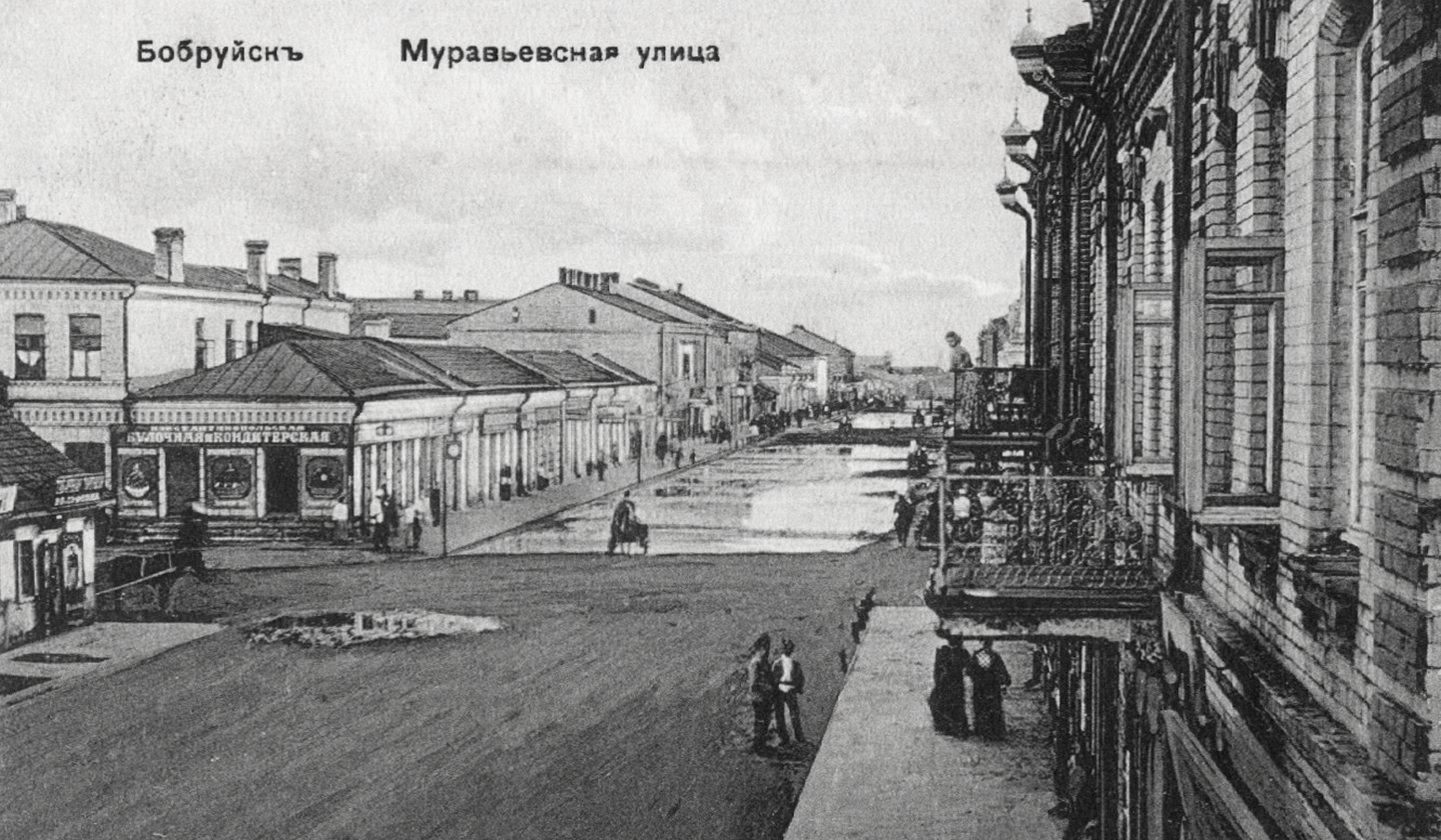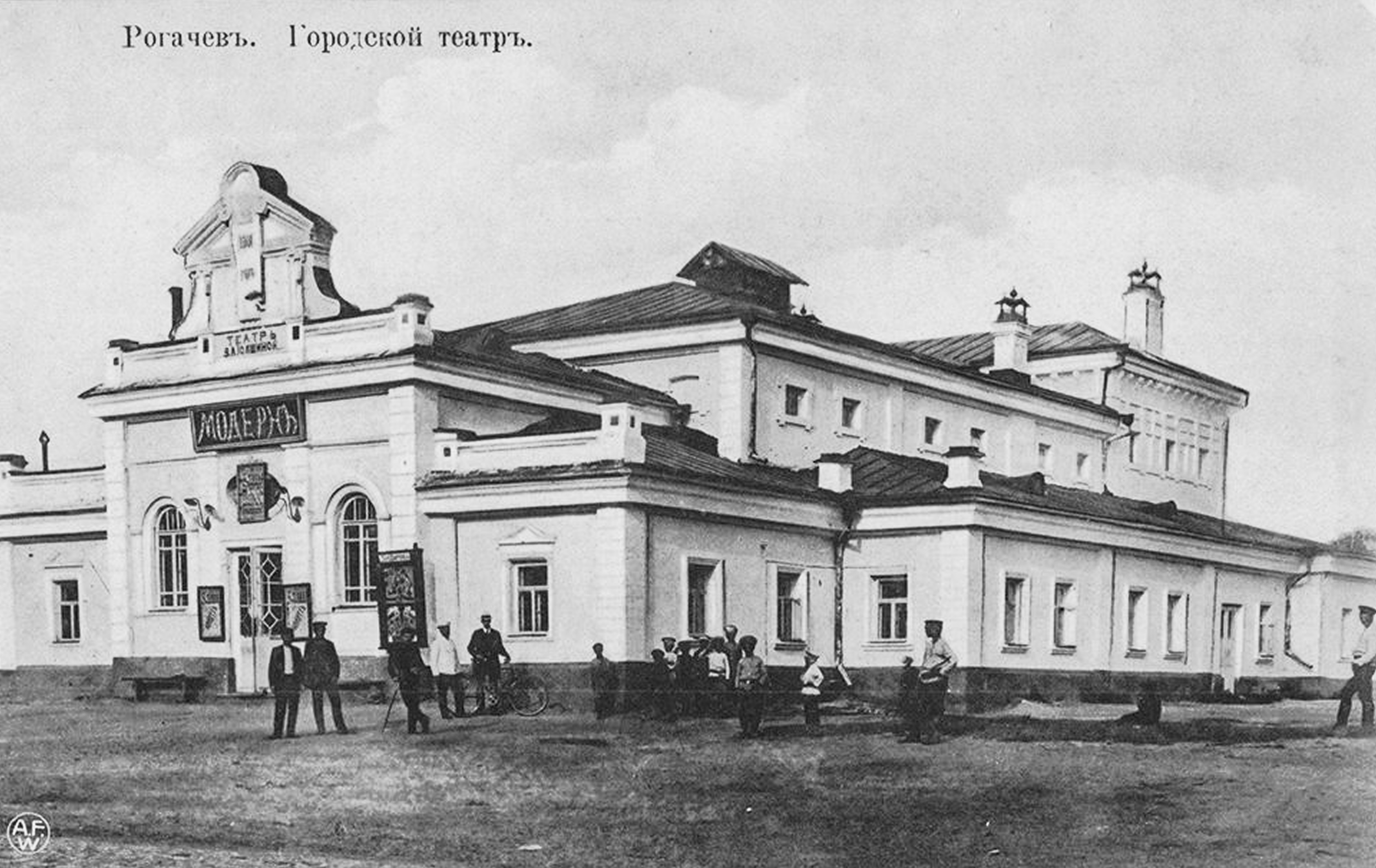A Golden Age of Belarusian Cinemas.
1911-1914
Bobruisk • Gomel • Rogachev
The correspondents who covered the other Belarusian cities did a lot of work between 1911-1914. The cities Bobruisk, Gomel and Rogachev all had theaters and avid film watchers.
Bobruisk
On the website Komkur.info, Ekaterina Danilchenko researched and wrote a 3 part history of cinema in Bobruisk that tells us that the cinema came to Bobruisk before 1910: “One line from The Chronicle of the City on the Byarez by A. M. Nenadovets sets the historical framework and confirms that The Whole World was indeed the very first: ‘In 1907, the first cinema in the city was opened, and its owner was Meshchanin Feinberg.’”1
There were three theaters by 1911, Giant, Whole World, and Eden.2
Bobruisk, Muravyovskaya street, Beginning of the XX century
Source: https://gorodminsk.blogspot.com/2016/03/blog-post_24.html
“From the bibliographic index "Familiar Streets, Forgotten Names", compiled by librarians and museum workers of Bobruisk, we can snatch just a couple of lines: "The center of the cultural life of Shosseinaya Street and nearby quarters in the pre-revolutionary years was the Railway Electro theater (later Proletary), which was located at the corner of Shosseinaya and Pushkinskaya (Bakharov and Pushkin). Tenant Mnushkin."3
Bobruisk, Muravyovskaya street, Beginning of the XX century
Source: Public domain, via Wikimedia Commons
This theatre had several other names in the early years. In another article, Danilchenko cites the book Down Shosseinaya Street by Abram Rabkin. In it, Rabkin cites a third person, who said the theater was called the Eden by some and the Illusion by others.4 In 1911,Cine-Phono called it the Eden and wrote that Mnushkin had owned the Eden, but stopped paying “anyone,” and so Varshavsky took it over.5
The early film journals also tell us that Belenky owned the Giant and Feinberg owned the The Whole World.6
Gomel
By April 1911, A. Stieff ran the "former Stremer" theater (remember Miss Volta?). Another theater, the Express-Bio, was described as “wretched, if not miserable,” and was run by M. Schneerson. There was also a New Railway Illusion, run by K.N. Libkin,7 and an Art theater run by Ehrlich, Rosenblum, and Naimark.8 Then, Shanovich came and built a new theater, which was described in 1912:
Cine-Phono Magazine
After that, we could not find Shanovich mentioned again in the journals.
Kine-Zhurnal reported on August 8, that the new Triumph theater opened in Gomel on August 10, 1912.10 “Everything in it — from the livery footman placed to the point of beauty — is beautiful, elegant."11
Stremer had opened his theater on Rumyantsevskaya Street, in the Tsyrlin house. “Soon it was called Moulin Rouge — in imitation of the famous Parisian variety show.”12 Gomel also had a cinema called Dreams.13
There was also an Eden theatre, which Koroshkevich bought in 1912, and the former Stremer was sold to Zagorny and Kulikovsky.14
Gomel, Bazar street, 1910
Source: https://commons.wikimedia.org
Vkontakte produced an article on early Gomel cinema, which said “…in 1911, in the best hotel in Gomel, the Savoy (on the site of today's old department store), the cinema Theater of Arts was opened. If you believe the advertising, the three-tiered hall of the Artistic for 800 seats was equipped according to the model of the best metropolitan cinemas. The Savoy Hotel and the station in Gomel were among the few places that had electric lighting.”15
Rogachev
Mr. Charnetsky tried to set up a theater in the city prior to January of 1911, but failed. Messrs. Levite and Lazar took over the premises, installed new power, and renamed the theater the Modern.16 The theater was successful enough that other entrepreneurs considered starting a second cinema.17
Rogachev, Modern theater, 1914
Source: https://commons.wikimedia.org
1 Данильченко, Екатерина/ Danilchenko, Ekaterina Загадки бобруйских кинотеатров”/“Mysteries of Bobruisk Cinemas” Коммерческий курьер/Commercial Courier 24 Oct. 2024. https://komkur.info/history-of-bobruisk/zagadki-bobrujskikh-kinoteatrov2 Accessed March 8, 2025.
2 Cine-Phono, No. 11, 1 March 1911, p. 19.
3 нильченко, Екатерина/ Danilchenko Ekaterina "Загадки бобруйских кинотеатров”/“Mysteries of Bobruisk Cinemas”
4 "Был кинозал на Новошоссеиной"/"There was a cinema hall on Novovoshossenynaya"
5 Cine-Phono, No. 13, 1 April 1911, p. 19.
6 Cine-Phono, No. 18, 25 May 1913, p. 26.
7 Cine-Phono, No. 13, 1 April 1911, p. 19.
8 Cine-Phono, No. 9, 1 Feb. 1912, p. 26.
9 Cine-Phono, No. 10, 15 Feb., 1912, p. 19.
10 Kine-Zhurnal, No. 15, 8 Aug. 1912, p. 19.
11 Kine-Zhurnal, No. 16, 23 Aug.1912, p. 20.
12 «С пианистами в 30-е и с драками и поножовщиной в 80-е. Как появились, развивались, процветали и умирали гомельские кинотеатры»/“With pianists in the 30s and with fights and stabbings in the 80s. How Gomel cinemas appeared, developed, flourished and died out”/Gomel Today. 25 Jan. 2023, https://vk.com/@gomeltoday-s-pianistami-v-30-h-i-s-drakami-i-ponozhovschinoi-v-80-h-kak Accessed March 8, 2025.
13 Ibid.
14 Cine-Phono, Nol 4, 15 Sept. 1912, pp. 29-30.
15 «С пианистами в 30-е и с драками и поножовщиной в 80-е. Как появились, развивались, процветали и умирали гомельские кинотеатры»/“With pianists in the 30s and with fights and stabbings in the 80s. How Gomel cinemas appeared, developed, flourished and died out”
16 Cine-Phono, No. 8, 15 Jan. 1911, p. 17.
17 Cine-Phono, No. 4, 15 Nov. 1911, p. 22.




